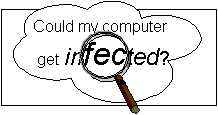

|
How Does a Computer Virus Infect a Computer? |
A macro virus becomes active when a document infected with the virus is opened using the program it is designed to attack. (So far--as of October 1997--only Microsoft Word, Microsoft Excel, and Lotus Ami Pro are vulnerable to macro viruses.) The program must have its ability to run macros enabled (turned on). Generally, when a virus in a document becomes active, it will spread to global settings for the application, so that other documents will become infected when they are opened. When an infected document is opened on another computer, the global settings used by that copy of the application will be infected as well.
A boot sector virus infects hard disks and diskettes. If a computer is re-booted or its power is turned on while an infected diskette is in drive A, the virus will spread to the hard disk, even if the diskette is not capable of starting up the computer. Once the hard disk is infected, all diskettes used in the computer will be infected and can spread the infection to other computers. On Macintoshes, a boot sector virus can become active when an infected diskette is inserted in a diskette drive because the Macintosh reads the diskette immediately.
A program virus becomes active when a program infected with a virus is run. Once a program virus is active, it will usually infect other programs on the computer. If a copy of an infected program is moved to and run on another computer, it can then infect programs on that computer.